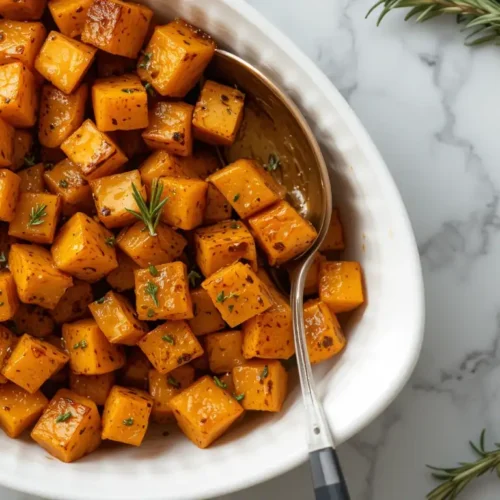
Roasted butternut squash
Discover the quickest way to delicious Roasted butternut squash! Simple, sattvic recipe for tender, sweet, wonderful taste every time.
Ingredients
- The Butternut Squash:
- Look for a squash that feels heavy for its size – this indicates good moisture content. The skin should be firm smooth, and matte, without soft spots or deep cuts. A deep, uniform beige color is ideal. A piece of the stem should still be attached. Choose a whole butternut squash if possible for better freshness. Selecting a good squash is the first step to a great recipe.
- The Cooking Fat:
- Ghee Clarified Butter: This is the preferred cooking fat in Ayurveda and sattvic cooking. Ghee has a high smoke point, a lovely nutty flavor, and is considered highly sattvic. It promotes digestion and calmness. A little goes a long way.
- Coconut Oil: A good vegan alternative. Choose virgin unrefined coconut oil. It has a pleasant, mild flavor suitable for roasting temperatures. Ensure it's fresh.
- High-Quality Olive Oil Use with Awareness: While less traditional than ghee, quality cold-pressed olive oil can be used sparingly, perhaps for finishing. Be mindful of its lower smoke point. For this roasted butternut squash recipe, ghee or coconut oil is best for roasting. We need just enough for a light coat on the squash cubes. A gentle drizzle works well.
- The Salt:
- Use pure unrefined salt like Himalayan pink salt or sea salt. Avoid iodized table salt. Salt enhances the natural sweetness of the squash.
Optional Sattvic Seasonings (See Section 6):
- Fresh herbs like sage mildly, or warming spices like cinnamon, ginger, or nutmeg. Quality matters – use fresh or recently purchased dried spices.
Instructions
Step 1: Wash and Dry
- Thoroughly wash the outside of the squash. Use a brush if needed. Pat it completely dry with a clean towel. A dry surface prevents slipping, crucial for safety.
Step 2: Trim the Ends
- Place the squash horizontally on a sturdy cutting board. Use a large, sharp chef's knife to carefully trim about half an inch from both ends. This creates flat, stable surfaces.
Step 3: Separate the Neck and Bulb
- Stand the squash upright on its wider cut end. Carefully slice the squash down the middle, separating the long neck from the round bulb where seeds reside. Alternatively, cut the squash horizontally first where the neck meets the bulb. Choose what feels most stable
Step 4: Peel the Squash
- Now, peel the squash. A sharp Y-shaped vegetable peeler often works best on the tough squash skin. Stand the neck piece on end and peel downwards. For the bulb, place it cut-side down for stability and peel the curve. Remove all skin and the pale green layer underneath. Using a peeler is safer than a knife here. Peel butternut squash completely.
Step 5: Cut the Bulb and Scoop Out Seeds
- Cut the squash in half – specifically the bulbous part, vertically. You'll see the cavity with squash seeds and stringy bits. Use a sturdy spoon to scoop out the seeds and membranes cleanly. Scoop everything out. You can discard these or save the butternut squash seeds to roast separately later for a snack. Ensure you remove all seeds and stringy parts.
Step 6: Cube the Squash
- Now it's time to cube the squash. Lay the peeled neck flat. Cut into 1-inch thick planks, then 1-inch wide strips, then 1-inch cubes. For the bulb halves, cut into 1-inch wide slices, then into 1-inch cubes. Aim for uniform squash pieces. You should now have a bowl of beautiful butternut squash cubes. This process helps cut butternut squash safely. You have prepared your squash in cubes.
Notes
Nutrition Information (per serving):
- Fat: 8-12g (mostly from ghee/coconut oil)
- Protein: 2-3g
- Carbohydrates: 25-30g
- Fiber: 4-6g
- Vitamin A: High (from beta-carotene)
- Vitamin C: Moderate
- Potassium: Moderate